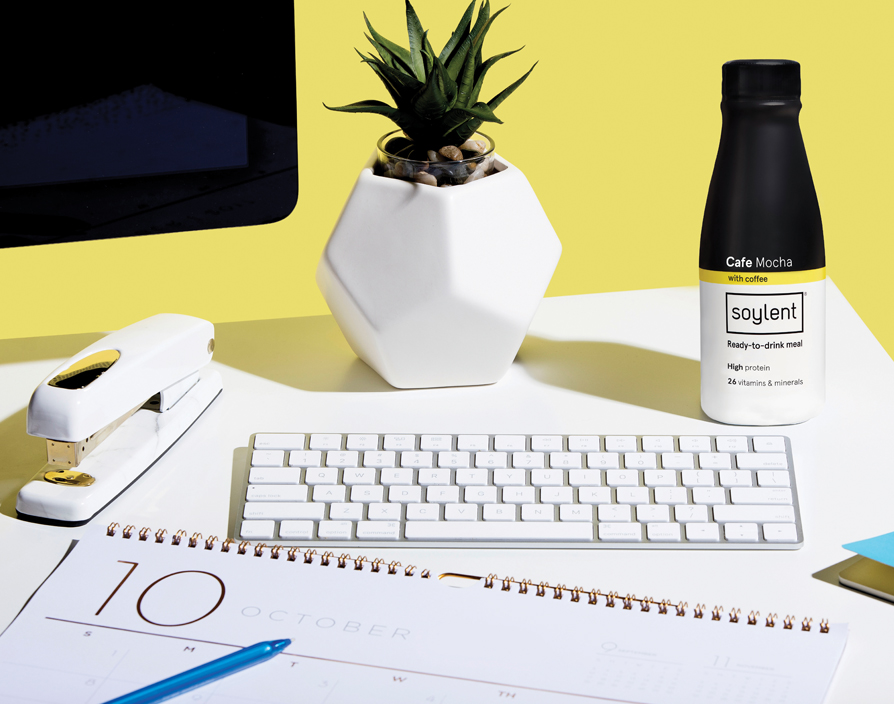Ultimately, Soylent plans to save the human race. “We’re setting out to change the way the world thinks about food,” announces Andrew Thomas, vice president of brand marketing at the meal replacement company. He argues current food production will leave people starving as the planet is set to have 9.7 billion people on it by 2050. But there’s a light at the end of the tunnel. “We believe technology and human ingenuity are really the solutions,” Thomas continues, suggesting the scaleup is just the company to do it. That’s some lofty aspiration from a company that’s essentially providing a hot rod version of SlimFast drinks.
Nevertheless, Soylent has reason to aim high. Since co-founder Rob Rhinehart launched it in 2013, its drinks have become Silicon Valley’s meal replacement of choice. The same year saw it raise the biggest foodtech crowdfunding round the world had ever seen and in the autumn of 2018 it made the jump across the pond, hoping to solve the hunger pangs of UK entrepreneurs, students, gamers and other high achievers. “It’s very exciting,” declares Thomas.
There are several explanations why Soylent has become as successful as it has. For starters, the foodtech industry is having a moment. “There’s a shift with consumers and how they think about nutrition,” claims Thomas. Naturally, investors have noticed. Funding for US foodtech startups jumped from $60m to $290m between 2008 and 2013, according to PitchBook, the financial data provider. Having reached the $1bn mark in 2015, VCs are still very interested in the sector. For instance, one of Soylent’s competitors, the UK-based powder food startup Huel, raised £20m in its first VC round in October 2018.
But that’s only part of the reason why Soylent piqued the interest of the Bay Area techies. At the time of its inception, Silicon Valley was under the thrall of the life-hacking movement where people bought into the notion that the right diet and exercises could dramatically improve their lives. Or to put it another way – by fine-tuning the fleshy hardware of their bodies, they aspired to maximise the processing power of the gelatine software inside their skulls and extend their warranty of life. While this pushed some enthusiasts to experiment with micro-dosing LSD, Soylent’s founder was less extreme – he only wanted to ensure his body received the nutrients needed to survive.
Whether it’s the rising tide of foodtech or Rhinehart tapping into the life-hacking movement – in 2013 he caught the interest of anyone that matters in the Bay Area. Back then, Rhinehart and his co-founders were working on a startup looking into creating affordable cell phone towers. “They were all working under the same roof, eating the same diet of frozen pizzas and instant ramen noodles,” Thomas tells. Rhinehart hated it, feeling the experience was unsatisfying, time-consuming and forgettable. There had to be a better way. Using the analytical mind he’d sharpened studying electrical engineering at Georgia Tech, he embarked on a mission to solve the problem. Deciding to experiment on himself, Rhinehart read up on everything he could find on nutrition and began mixing the chemical form of the 35 nutrients humans need to survive. These included potassium gluconate, calcium carbonate and monosodium phosphate. As he pursued his undertaking for more than 30 days, he blogged about his experience. “The blog went viral,” Thomas says. “This idea of someone living off this product for a month or two [was] just so interesting.”
When his first startup failed, despite being backed by the legendary Y Combinator incubator, which has supported the likes of Airbnb, Dropbox, Reddit and Twitch to name a few, Rhinehart decided to turn the buzz around his experiment into a product. He picked the name from Harry Harrison’s 1966 novel Make Room! Make Room!. The book imagines a world in which overpopulation has led to food shortages, resulting in riots when a store has soy and lentil – or soylent – burgers on sale.
While not violent in any way, Soylent caused a virtual stampede of its own in 2013 when it launched a campaign on the crowdfunding portal Crowdhoster. Tempted by the idea of taking control of their own nutrition and time, over 10,000 people pre-ordered over $1.5m worth of products. Clearly, plenty of people had zero time to do something as pedestrian as clocking out for a Big Mac. “Even today, that’s the largest crowdfunding campaign in history for a food or beverage,” claims Thomas.
Having already raised awareness with the blog and proving the demand unsurprisingly meant big investors soon came knocking. “Anytime you have a brand or a product that catches fire in the way that Soylent did initially, it’s bound to draw attention,” shrugs Thomas. The meal-replacement product was no exception. In October 2013, Soylent revealed that it had secured a seed round worth $1.5m from VC investors Andreessen Horowitz and Lerer Hippeau. This and four more rounds have seen the company raise $72.4m in total. “There was this tension, there was this pain point for [consumers],” Thomas explains the VCs’ interest. “This product helped solve that and there are so many more consumers out there who have this pain point.” These different rounds enabled Soylent to move away from only offering powder supplements to providing complete drinks that are sold on Amazon and, since July 2017, in US 7-Eleven stores.
That doesn’t mean the company hasn’t had a few setbacks. For instance, in 2016 the scaleup recalled the Soylent Bar after it reportedly caused gastrointestinal illness, including nausea, vomiting and diarrhoea. Moreover, in October 2017, the Canadian Food Inspection Agency banned Soylent from selling its product in the country. “They said, ‘You don’t align with what we believe is a meal replacement,’” Thomas explains. While the scaleup is still not available in the country, it’s working to reformulate its offerings and return to the nation. “Fortunately for Canada, we want to get back there,” Thomas says.
Feeling he had taken the company through its startup phase, Rhinehart stepped down as CEO in December 2017 to ensure the scaleup could continue to grow. He passed the torch to Bryan Crowley, president of Rosa Foods, Soylent’s parent company. Remaining the business’ biggest shareholder and chairman, Rhinehart wrote a blog entry to explain his decision. “If you love something, set it free,” he wrote. “Soylent and the people involved have become the loves of my life. Starting from scratch and turning my passion for a better food system into a booming business with world class products and employees has been the experience of a lifetime.”
And Soylent’s certainly still steaming ahead under its new leadership. In September 2018, it announced it would begin to sell its products in the UK. Having learned from its Canadian misadventure, Soylent ensured it adhered to the EU’s rules before entering Blighty. “We obviously worked very closely with all the appropriate regulatory bodies to ensure that we were in compliance and that we had a product they deemed safe for the consumers,” Thomas explains. This dialogue resulted in Soylent swapping seven genetically modified ingredients with non-modified ones to ensure it complied with UK laws, paving the way for its British launch. “And in general the reception has been positive,” Thomas suggests. “We’ve got a lot of press coverage and there has certainly been some outlets who haven’t been [as big a] superfan of the taste as we’d like them to be.”
At the moment, Soylent’s products are only available in the UK via Amazon but Thomas suggests there is a plan to introduce it in grocery stores. Although, he doesn’t know when that will happen. “That’s the million-dollar question,” Thomas explains. “We don’t have a timeline set for that just yet.” At the moment, Soylent is focused on tracking how the drinks are received in the UK, how well it sells and what the press say about the bottled meals. While there’s no set date, he’s confident it will be sooner rather than later. “My guess is that we won’t take as long to go click to brick,” Thomas promises. “My guess is that it won’t be the four or five years that it took to get us here [in the US]. My sense is that it would be sooner.”
Putting aside that the name invokes dystopian famine and fighting, Soylent may be well on its way to changing the way you eat.
Share via:








































